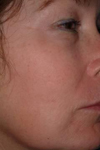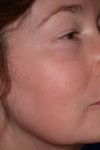 During a chemical peel, chemical solutions of varying strengths are carefully brushed onto the skin. The chemicals remove skin cells on the surface of the skin and stimulate the production of new skin cells below. This leaves the skin smoother, less wrinkled, and more youthful in appearance.
During a chemical peel, chemical solutions of varying strengths are carefully brushed onto the skin. The chemicals remove skin cells on the surface of the skin and stimulate the production of new skin cells below. This leaves the skin smoother, less wrinkled, and more youthful in appearance.
Chemical peels can be used effectively for a wide range of skin conditions including:
- Fine lines and wrinkles
- Uneven pigmentation
- Shallow acne scars
- Sun-damaged skin
- Age spots
- Freckling
 Chemical peeling can be performed on the face, neck, chest, hands, arms, or legs. It is most effective at changing the appearance on the surface of the skin. Effects of aging in deeper tissues, such as drooping eyelids and loose skin below the chin, must be treated with other procedures.
Chemical peeling can be performed on the face, neck, chest, hands, arms, or legs. It is most effective at changing the appearance on the surface of the skin. Effects of aging in deeper tissues, such as drooping eyelids and loose skin below the chin, must be treated with other procedures.
Chemical peels are categorized by how deeply the chemicals penetrate the skin: superficial, medium, or deep. Superficial peels use mild chemicals, such as alpha-hydroxy acids, which penetrate only the uppermost layer of the epidermis. Medium and deep peels use stronger agents.
A superficial chemical peel is usually sufficient to treat fine lines and wrinkles around the eyes and mouth. These may be referred to as "lunchtime peels". Patients with minimal skin damage often respond best to a series of superficial peels combined with a skin care regimen, including topical retinoids and daily sunscreen use.
A medium-depth peel is more effective for patients with moderate skin damage, including age spots, freckles, and actinic keratoses. It may be combined with another treatment such as laser resurfacing for maximum effectiveness.
Deep chemical peels may require bandages to be applied for 1-3 days following treatment. In addition, ointments and creams may be recommended to keep the skin moist. Cosmetics can be applied after about two weeks.
During treatment, most patients experience a warm sensation for about ten minutes, followed by some stinging. Anesthesia may be recommended for deep peels.
In general, the deeper the peel, the longer the recovery. A superficial peel produces redness similar to mild sunburn and lasts 3 to 5 days. Medium or deep peels can make the skin look severely burned, sometimes with blistering and peeling for 7 to 14 days. You may be prescribed pain relievers to reduce the discomfort following a deep peel.
Following a treatment, treat your skin gently. Avoid sun exposure because the renewed skin will be tender and susceptible to injury.
Following a chemical peel, your new skin will be tighter, smoother, and perhaps slightly lighter in color than before surgery.
Source: Vivacare
Last updated : 5/13/2022